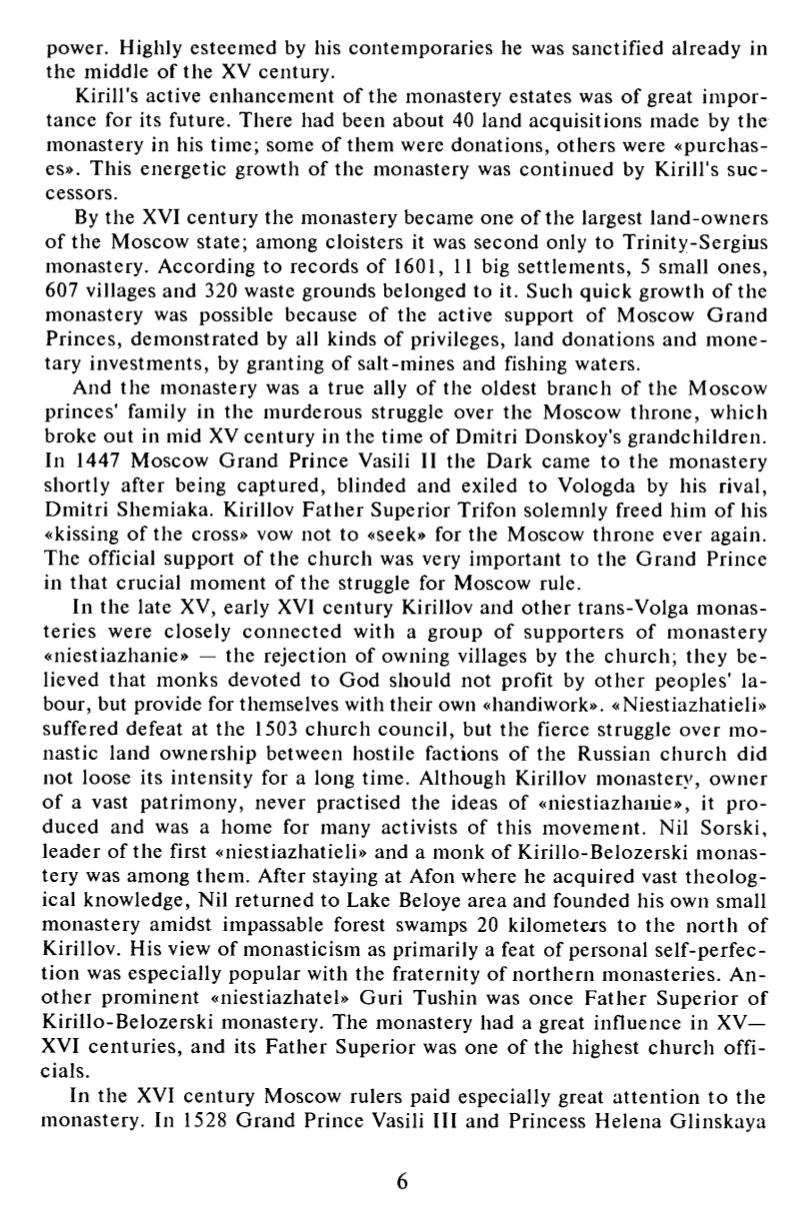

power. Highly esteemed by his contemporaries he was sanctified already in
the middle o f the XV century.
Kirill's active enhancem en t o f the monastery estates was o f great im po r
tance for its future. There had been about 40 land acquisitions made by the
monastery in his time; some of them were donations, o thers were «pu rchas
es». This energetic growth o f the monastery was con tinued by K irill's su c
cessors.
By the XVI cen tury the monastery became one o f the largest land -owners
o f the Moscow state; among cloisters it was second only to T rin ity-Serg ius
monastery. According to records of 1601, 11 big settlem en ts, 5 small ones,
607 villages and 320 waste grounds belonged to it. Such quick growth o f the
monastery was possible because of the active support o f Moscow G rand
Princes, demonstrated by all kinds o f privileges, land donations and m on e
tary investmen ts, by granting o f salt-m ines and fishing waters.
And the monastery was a true ally o f the oldest branch of the Moscow
p rinces' family in the murderous struggle over the Moscow th rone , which
broke out in mid XV century in the time of Dmitri Donskoy's g randch ildren .
In 1447 Moscow G rand Prince Vasili II the Dark came to the monastery
shortly after being cap tu red , blinded and exiled to Vologda by his rival,
Dm itri Shemiaka. Kirillov Fa ther Superior Trifon solemnly freed him o f his
«kissing o f the cross» vow not to «seek» for the Moscow th rone ever again.
The official support of the church was very importan t to the G rand Prince
in th a t crucial moment o f the struggle for Moscow rule.
In the late XV, early XVI century Kirillov and o ther trans-Volga m onas
teries were closely conn ec ted with a group o f suppo rters o f m onastery
«niestiazhanie» — the rejection o f owning villages by the chu rch ; they b e
lieved that monks devoted to God should not profit by o th e r peoples' la
bour, but provide for themselves with their own «handiwork». «Niestiazhatieli»
suffered defeat at the 1503 chu rch council, but the fierce struggle over m o
nastic land ownership between hostile factions o f the Russian chu rch did
not loose its in tensity for a long time. Although Kirillov monastery, owner
o f a vast patrimony, never practised the ideas o f «niestiazhanie», it p ro
duced and was a home for many activists of th is movement. Nil Sorski,
leader o f the first «niestiazhatieli» and a monk o f K irillo-Belozerski m onas
tery was among them . After staying at Afon where he acqu ired vast th eo lo g
ical knowledge, Nil returned to Lake Beloye area and founded his own small
monastery amidst impassable forest swamps 20 kilometexs to the no rth of
Kirillov. His view o f monasticism as primarily a feat o f personal self-perfec-
tion was especially popular with the fraternity o f no rthe rn monasteries. A n
o th e r prom inen t «niestiazhatel» Guri Tushin was once F a ther Superior of
K irillo-Belozerski monastery. The monastery had a great influence in XV—
XVI cen tu ries, and its Fa ther Superior was one o f the highest chu rch o ffi
cials.
In the XVI cen tury Moscow rulers paid especially great a tten tion to the
monastery. In 1528 G rand Prince Vasili III and Princess Helena G linskaya
6















